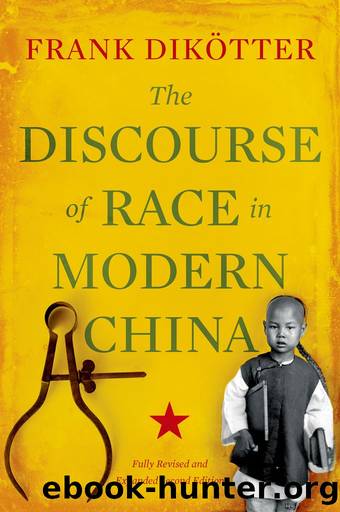The Discourse of Race in Modern China by Dikötter Frank;

Author:Dikötter, Frank; [Dikötter, Frank;]
Language: eng
Format: epub
ISBN: 9780190231132
Publisher: OxfordUP
Published: 2015-09-15T00:00:00+00:00
Expansion
Interest in eugenics exploded with the New Culture Movement. Professor Chen Yinghuang, author of one of the first anthropological textbooks in China, briefly mentioned how eugenics was a science capable of improving society by expelling its diseased elements, a process he called renzhong gailiang, âimprovement of the raceâ, or youshengxue, âscience of superior birthâ.25 The term youshengxue would rapidly become mainstream. It resonated with evolutionary views of the world as an arena of struggle between races, bringing to mind the expression âstruggle for survivalâ (yousheng liebai, literally âthe superior win, the inferior loseâ). It was homophonous with âscience of how the superior winâ.
A further call for racial improvement appeared in the journal New Education in 1919. Xia Yuzhong, the editor of Beijing Normal Universityâs textbooks and a professor of Chinese literature, deplored the fact that modern civilisation, despite all its material progress, was marred by a proliferation of unfit elements. âSociety is still crammed with all the evil, the ugly, the false, the wicked, the scrambling, the base, the stupid, the brutish and the vexing elements of the human race, filled with all the bad phenomena that could lead a superior person to commit suicide.â Medical experts, Xia recommended, should strictly distinguish between healthy individuals to be preserved and unfit elements to be eliminated. Each province should have a specialised eugenics laboratory, while breeding villages should be established for people with perfect brains and ideal bodies in order to generate the future âmodel raceâ.26
Articles introducing a broad readership to the Eugenics Laboratory of Sir Francis Galton, the Eugenics Education Society of Leonard Darwin and the work of American eugenists such as Charles Davenport soon followed.27 One of the first comprehensive treatises on eugenics written for the general reader appeared in 1923. The slim volume was coauthored by Zhou Jianren, the science editor of the Commercial Press in Shanghai and brother of Lu Xun, and Chen Changheng, a specialist in demography.28
Evolution and Eugenics rapidly became a best-seller. The authors started by pointing out that progress in human societies had always been hampered by racial degeneration. Great civilisations such as Babylon, Greece, Rome, Spain and Turkey had collapsed as a consequence of racial decrepitude, and China, they warned, would soon go the same way. Eugenics would empower the state to direct the course of social evolution. Following the reformers, Chen harped on the theme of racial extinction. He described how Western countries were actively engaged in eugenic policies and how they had succeeded in progressively raising the vitality of the âraceâ. Whereas the âracesâ of the West were becoming increasingly strong and vibrant, ânational subjugation and racial extinctionâ (wangguomiezhong, a concise and frequently used epigram) were thought to pose a threat to a Middle Kingdom in decay.29
Zhou Jianren explained the principles of evolution and the mechanisms of heredity. Statistics proved that not only physical characteristics, but also mental traits could be inherited: parents suffering from low intelligence could not produce bright children.30 As was explained in Chapter 4, belief in the inheritance
Download
This site does not store any files on its server. We only index and link to content provided by other sites. Please contact the content providers to delete copyright contents if any and email us, we'll remove relevant links or contents immediately.
| Central Asia | Southeast Asia |
| China | Hong Kong |
| India | Japan |
| Korea | Pakistan |
| Philippines | Russia |
The Sympathizer by Viet Thanh Nguyen(4309)
The Rape of Nanking by Iris Chang(4141)
World without end by Ken Follett(3432)
Ants Among Elephants by Sujatha Gidla(3418)
Blood and Sand by Alex Von Tunzelmann(3140)
Japanese Design by Patricia J. Graham(3113)
City of Djinns: a year in Delhi by William Dalrymple(2516)
The Queen of Nothing by Holly Black(2499)
Foreign Devils on the Silk Road: The Search for the Lost Treasures of Central Asia by Peter Hopkirk(2435)
India's Ancient Past by R.S. Sharma(2417)
Inglorious Empire by Shashi Tharoor(2396)
Tokyo by Rob Goss(2390)
In Order to Live: A North Korean Girl's Journey to Freedom by Yeonmi Park(2349)
India's biggest cover-up by Dhar Anuj(2321)
Tokyo Geek's Guide: Manga, Anime, Gaming, Cosplay, Toys, Idols & More - The Ultimate Guide to Japan's Otaku Culture by Simone Gianni(2318)
The Great Game: On Secret Service in High Asia by Peter Hopkirk(2306)
Goodbye Madame Butterfly(2209)
Batik by Rudolf Smend(2128)
Living Silence in Burma by Christina Fink(2038)
